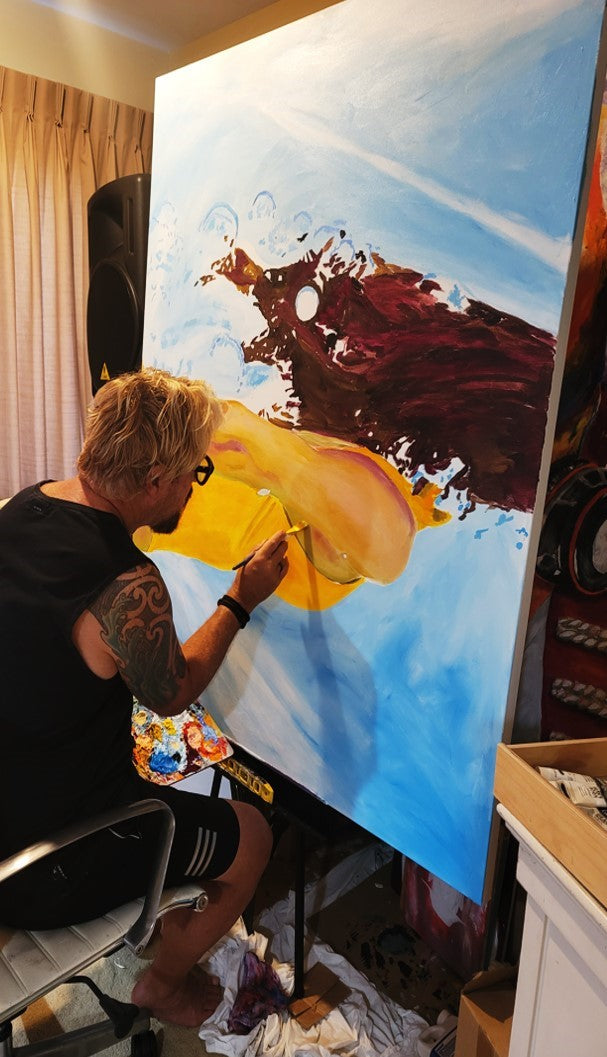CANVAS PRINT VS PAPER PRINTS
Canvas Prints:
Texture: Canvas prints have a textured surface that adds depth and dimension to the artwork. This texture often mimics the look and feel of traditional paintings or gallery art works.
Durability: Canvas prints are typically more durable than paper prints. They are less prone to tearing, creasing, or damage from moisture compared to paper.
Versatility: Canvas prints can be stretched onto wooden frames, allowing them to be displayed without the need for additional framing. They can also be varnished for added protection and a glossy finish.
Modern Aesthetic: Canvas prints are often associated with a contemporary, gallery-style look, making them a popular choice for modern interiors.
Cotton Paper Prints:
Texture: Cotton paper prints have a smooth surface that offers excellent clarity and detail, making them ideal for high-resolution printing. The lack of texture provides a clean and crisp appearance.
Authenticity: Cotton paper has been used for centuries in traditional printing processes due to its archival quality and longevity. Prints on cotton paper often have a classic, timeless appeal.
Matte Finish: Cotton paper prints typically have a matte finish, which reduces glare and reflections, making them suitable for displaying in well-lit environments or under glass.
Traditional Charm: Cotton paper prints evoke a sense of craftsmanship and tradition, making them a popular choice for fine art reproductions and vintage-inspired designs.
“I want people to feel something when they experience my art.”
Peter Ashworth, is a California Impact Artist, who seeks to evoke profound emotions and inspire transformation through his art. As a creator, adventurer, and philanthropist, his purpose is to enrich lives and uplift communities worldwide.
'I have a hundred new creative ideas every day, many that manifest into my art.”
Believing in the power of exceptional art to engage, entertain, and uplift, he aims to spark imagination and encourage self-expression. With a keen eye for color and design honed over decades in corporate branding and advertising design, he crafts art that resonates with viewers, inviting them to think deeper and connect with their true selves. Through his creative process, Peter aims to make a positive impact on individuals, homes, society, and the environment. He sees a world where art creates impact and uplifting experiences, encourages well-being and fosters positive change in people.

Great Art Will Change Your Life.
Pair text with an image to focus on your chosen product, collection, or blog post. Add details on availability, style, or even provide a review."It is my genuine hope that my art in your home will bring about a profound transformation in your life. Beyond mere decoration, art has the power to evoke emotions, provoke thoughts, and inspire creativity, fostering a deeper connection with your surroundings. I believe art has the potential to uplift your mood, reduce your stress, and promote overall well-being,.... creating a harmonious and nurturing environment where you can thrive. By surrounding yourself with pieces of art that resonate with you, you can create a personal sanctuary that reflects your style, values, aspirations, and aesthetic preferences.
My art is designed from the first brushstroke .... to create
impact and stimulation in your environment. I have 6 different collections, each designed to provide you a unique, personalized, and interesting creative space. The presence of my art in your home or workplace will truly elevate your life, fostering a sense of meaning, creativity, and connection that can permeate into every aspect of your worldview and daily life."
Great Art Can Change The World
He also founded a non-profit (Humanity We -humanitywe.org) a highly innovative solution to address extreme poverty in small communities around the world. The purpose of Humanity We is to move entire poor communities out of dehumanizing generational poverty. His life purpose is to uplift the lives of others through art, philanthropy, and helping others live better lives.
20% of all proceeds from his art goes to fund Humanity We, a registered 501.c.3 charity, which maybe tax-deductible to you as an individual or organization.
The Origin Story
His creativity was inspired by his upbringing on farms in rural New Zealand, where he was transfixed with creative thinking, adventure, and the juxtaposition of colors, composition, and design. Throughout his life, he has traveled and lived in multiple countries of the world, living in the USA for the past 35 years. He is an avid sailing Captain who enjoys ocean sailing in the most interesting places around the world. For many years he has studied human thinking - how the brain perceives and assimilates information and experiences (neuroplasticity), and how humans experience emotional impact and create understandings and worldviews. He now lives in Southern California, one of the foremost creative epicenters of the world. He lives in a world-famous small artist town, Laguna Beach, living close to the Pacific Ocean, where he gets much of his daily creative ideas and inspiration. In his past careers, he spent many years managing super-luxury hotels around the world, then created six Marketing and Branding agencies, where he honed his CEO, Consulting, and Creative Design skills in business strategy, imaginative design, and human interaction – overseeing advertising and storytelling for many well-known global brands and hundreds of small & medium-sized businesses.
Live a smaller footprint.
My journey into sustainable artistry began with two simple yet profound questions to myself: (1) How can art be created without leaving a heavy footprint on the environment? ….and (2) How can art and creativity create more fulfilling lives for people, and influence them to live better with less? These questions ignited my quest for innovation and a deep dive into sustainable art practices that have come to define my artistic process and methodologies…. and my core worldview. I advocate for embracing a lifestyle that minimizes our environmental footprint, encouraging moderation in consumerism, resisting the urge for excessive consumption, and prioritizing low carbon-high sustainability lifestyles and values whenever possible.




